

Agada Tantra, also known as Vishachikitsa, is one of the eight classical branches (Ashtanga Ayurveda) that deals with the science of toxicology. It focuses on the identification, prevention, diagnosis, and management of poisoning caused by various agents, both natural and artificial.
Agada Tantra encompasses the study of Visha (toxins),
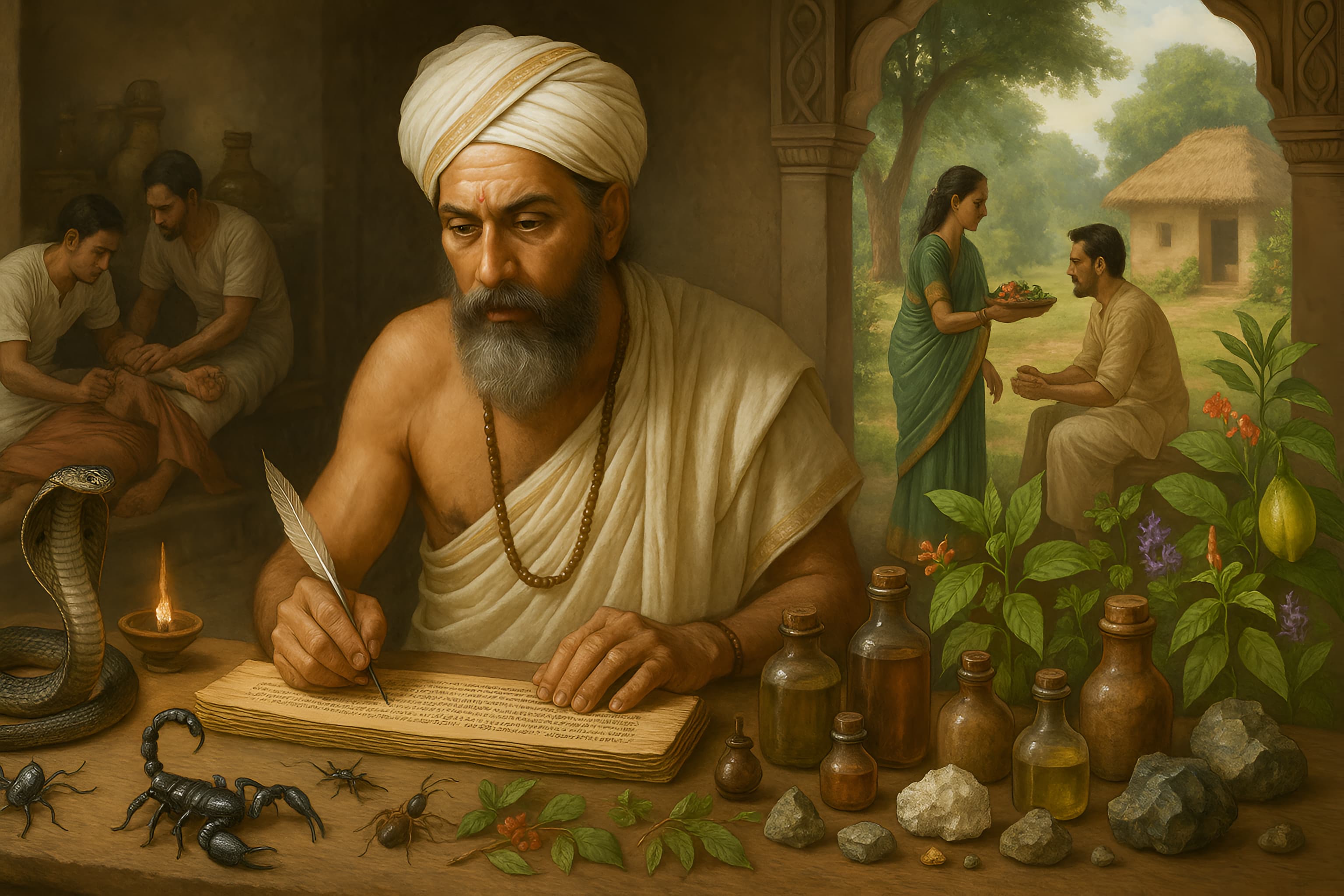
which are categorized into different types—animate (Jangama Visha) such as snake, scorpion, and insect bites;
inanimate (Sthavara Visha) like poisonous plants, minerals, and chemicals; as well as subclinical, residual, and cumulative toxic effects from long-term exposure.It provides comprehensive knowledge about the origin, properties, effects, and antidotes for these toxic substances.
The principles of Agada Tantra are deeply rooted in preventive medicine. The branch emphasizes early detection of toxins, use of herbal antidotes, detoxification procedures, and dietary modifications to neutralize harmful effects. It also includes emergency management protocols for acute poisoning and long-term strategies for chronic toxicity.
Agada Tantra finds modern relevance in the management of drug poisoning, food contamination, environmental pollutants, and lifestyle-related toxic exposures. It aligns well with contemporary toxicology and environmental health sciences.
In addition, this branch contributes significantly to forensic medicine, offering traditional methods for post-mortem examination and medico-legal investigations.
With the rise in environmental toxins and chemical exposure in modern times, Agada Tantra stands as a vital, preventive, and curative science that reflects Ayurveda’s timeless wisdom in safeguarding health and life.
Dravyaguna Vigyan is a vital branch of Ayurveda that focuses on the pharmacological study of medicinal substances, primarily derived from plants. It lays the foundation for understanding the therapeutic properties, actions, and applications of herbal drugs in Ayurvedic practice. This branch integrates classical Ayurvedic principles with modern scientific approaches to meet the growing demand for evidence-based validation of natural medicines.
The scope of Dravyaguna includes a comprehensive study of the Rasa (taste), Guna (qualities), Veerya (potency), Vipaka (post-digestive effect), and Prabhava (specific action) of each drug. It also emphasizes the correct identification of medicinal plants, their botanical classification, the part used (like root, leaf, bark, or flower), cultivation practices, sustainable collection methods, preservation, and storage techniques to ensure safety and efficacy.

With increasing global acceptance of herbal medicines, the standardization and quality control of Ayurvedic drugs have become essential. Dravyaguna Vigyan plays a crucial role in the chemical profiling, pharmacovigilance, and toxicity studies of plant-based medicines. It also deals with controversial or unidentified drugs, finding appropriate substitutes and identifying adulterants to maintain authenticity in raw materials.
This branch bridges the gap between traditional wisdom and modern science, promoting safe, effective, and standardized Ayurvedic therapies. As the world shifts toward natural and holistic healing, Dravyaguna Vigyan continues to be the cornerstone for the development, validation, and responsible use of herbal medicines in contemporary healthcare.
Balaroga (Kaumarbhritya) is a vital branch of Ashtang Ayurveda focused on child health from conception to 16 years of age. “Kaumar” means child, and “Bhritya” refers to care and hygiene. It emphasizes preventive and curative measures for neonatal care, infant feeding, nutrition, immunization, and management of childhood diseases. Ayurvedic scholars believe that proper care during this period forms the foundation of a healthy life, as children differ physiologically from adults in Dosh, Mala, and Dhatu, requiring specialized approaches to disease management.
The aim of the Balaroga Department is to ensure children’s physical, mental, and social well‑being while preventing diseases through immunity‑boosting practices like Suvarnaprashan and vaccination.
.png)
Objectives include preparing skilled clinicians and academicians, imparting in‑depth knowledge of Balaroga, providing optimal neonatal and pediatric care, reducing morbidity and mortality, and preventing complications through proper resuscitation.
Facilities include regular OPD, neonatal care units, high‑risk clinics, IPD services, special Ayurvedic treatments, and Panchakarma procedures for childhood disorders. Counseling sessions are conducted for parents regarding neurological development. Various health programs like Suvarnaprashan camps, school health check‑ups, vaccination drives, and yoga‑pranayama camps are organized to promote holistic child development and well‑being.
Kayachikitsa is one of the eight branches of Ayurveda (Ashtanga Ayurveda) and deals with the diagnosis, prevention, and treatment of systemic diseases. The word "Kaya" refers to the body and especially the Agni (digestive/metabolic fire), which plays a central role in health and disease. "Chikitsa" means treatment or therapy. Thus, Kayachikitsa emphasizes restoring balance to the internal systems of the body, particularly by correcting impaired Agni and Doshas (Vata, Pitta, Kapha).

This branch addresses a wide range of disorders, including fever (Jwara), diabetes (Prameha), skin diseases (Kustha), respiratory conditions, digestive disorders, neurological issues, and psychological conditions. Treatment involves a holistic approach using herbal formulations, Panchakarma (detoxification), Rasayana (rejuvenation), dietary regulation, and lifestyle modifications.
Kayachikitsa emphasizes personalized treatment based on individual constitution (Prakriti), disease nature (Vikruti), season, age, and strength. It integrates mind-body healing, recognizing the influence of mental and emotional health on physical well-being.
In modern times, Kayachikitsa is gaining global recognition for its natural, preventive, and curative approach, especially in managing chronic and lifestyle-related diseases. It forms the clinical foundation of Ayurvedic practice, empowering physicians to treat disease at its root rather than just alleviating symptoms.
Kayachikitsa, a major branch of Ayurveda, focuses on the diagnosis, treatment, and prevention of various internal diseases. The term "Kaya" refers to the body, and "Chikitsa" means treatment, thus Kayachikitsa broadly translates to internal medicine. It encompasses a wide range of conditions, including metabolic, lifestyle, and systemic disorders.
One of its specialized sub-branches is Rasayana, which deals with geriatric medicine. It aims to promote longevity, enhance immunity, and improve overall vitality through rejuvenating therapies and herbal formulations. Another important division is Vajikarana, which focuses on enhancing reproductive health, libido, and vitality, and is often used to treat infertility and sexual dysfunction.
Kayachikitsa also plays a vital role in managing chronic skin disorders like psoriasis, eczema, and vitiligo using internal detoxification, diet, and herbal treatments. Diabetes (Madhumeha) and other lifestyle disorders are addressed through personalized regimens, Panchakarma (detoxification), and herbal medicines, aiming to correct imbalances at the root level.
Furthermore, it offers effective management of arthritis and joint disorders, using anti-inflammatory herbs and therapeutic procedures. Kayachikitsa emphasizes not only treating the disease but also restoring balance and preventing recurrence through a holistic approach that integrates diet, behavior, mental health, and natural medicine.
Kriya Sharira is a foundational branch of Ayurveda that deals with the normal functioning of the human body based on Ayurvedic principles. It explains how life processes are governed by the balance and interaction of Tridosha (Vata, Pitta, and Kapha), Saptadhatu (seven body tissues), Trimala (three waste products), and Agni (digestive/metabolic fire).

In Ayurveda, physiology is not just limited to anatomical functions but also includes mental, emotional, and spiritual aspects of the human system. Kriya Sharira provides a holistic understanding of how various internal systems maintain health through natural rhythms and harmony. The concept of Prakriti (individual constitution) is unique to this branch, helping practitioners understand the natural tendencies, strengths, and vulnerabilities of each individual.
The study of Agni and Ama (toxins), Ojas (vital essence), and Srotas (channels) forms an important part of Kriya Sharira, as these directly influence digestion, immunity, and overall vitality.
Kriya Sharira bridges the ancient understanding of human physiology with modern interpretations, offering insights into disease prevention and health maintenance. It is the scientific and philosophical backbone of Ayurvedic diagnosis and treatment, making it an indispensable part of Ayurvedic education and practice.
Panchakarma is a classical Ayurvedic therapy that aims to detoxify, rejuvenate, and restore balance in the body. The term "Panchakarma" means "five actions" or procedures, each designed to eliminate deep-rooted toxins (Ama) from different systems of the body and correct the imbalances of the Tridoshas (Vata, Pitta, and Kapha).
The five main procedures are:
Before these main therapies, Purva Karma (preparatory procedures) like Snehana (oleation) and Swedana (sudation) are performed to loosen and mobilize toxins. After Panchakarma, Paschat Karma involves diet regulation and lifestyle adjustments to support recovery and rejuvenation.
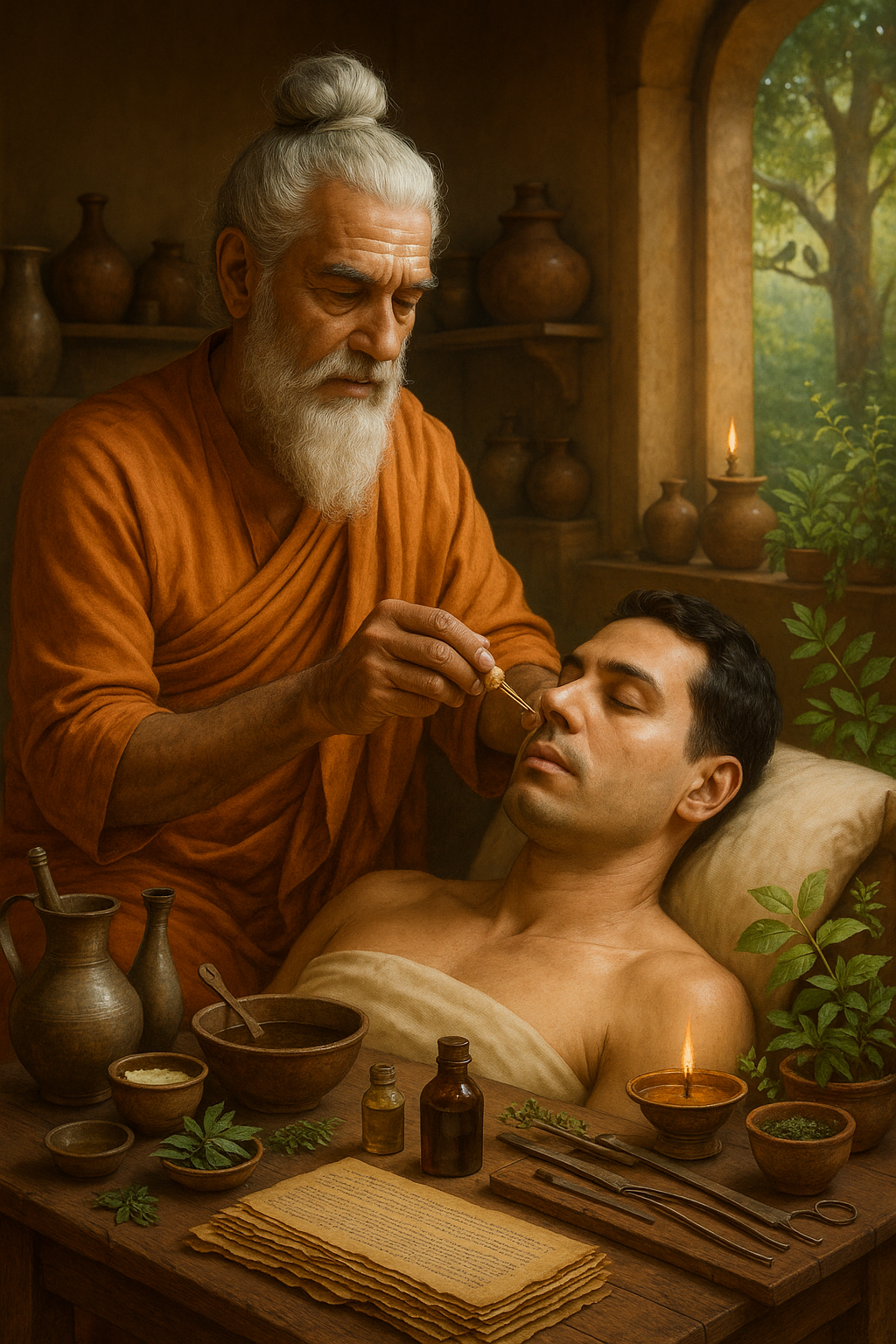
Panchakarma not only treats chronic diseases but also promotes longevity, strengthens the immune system, and enhances mental clarity. It is especially effective in managing conditions such as arthritis, skin disorders, digestive issues, stress, and metabolic imbalances.
More than a detox program, Panchakarma is a comprehensive healing system rooted in natural principles. It reflects Ayurveda’s holistic approach, offering physical, mental, and spiritual purification for maintaining and restoring optimal health.
Prasuti Tantra evam Stri Roga is one of the key clinical branches of Ayurveda that deals with the health of women, focusing on gynecology (Stri Roga) and obstetrics (Prasuti Tantra). This branch provides detailed guidance on female reproductive health, menstrual disorders, conception, pregnancy care, delivery, and postnatal care.
Stri Roga includes the study, diagnosis, and management of disorders related to the uterus, ovaries, menstrual cycle, infertility, leucorrhea, PCOD, and menopausal symptoms. Ayurveda emphasizes the balance of Doshas, especially Apana Vata, in maintaining reproductive

health. Herbal formulations, diet, lifestyle changes, and Panchakarma therapies are used for treatment.
Prasuti Tantra deals with antenatal care (Garbhini Paricharya), safe delivery (Sutika Paricharya), and neonatal care. It outlines the ideal regimen for each month of pregnancy to ensure the health of both mother and child. Postnatal care focuses on restoring maternal health, enhancing lactation, and promoting emotional well-being.
With growing concerns about hormonal disorders and fertility issues, Prasuti Tantra evam Stri Roga offers safe, natural, and holistic alternatives. It respects the unique physiology of women and supports their health through all stages of life—puberty, fertility, pregnancy, and menopause.
Rachana Sharir is a core branch of Ayurveda that deals with the structural study of the human body, which includes bones, muscles, organs, tissues, systems, and body channels. It is comparable to modern human anatomy but is approached through the philosophical and functional lens of Ayurveda.
The term "Rachana" means structure, and "Sharir" means body. This branch describes the composition and organization of the human body based on Ayurvedic concepts such as Panchamahabhuta (five elements), Tridosha (Vata, Pitta, Kapha), Saptadhatu (seven tissues), Trimala (three waste products), Srotas (channels), and Marma (vital points).
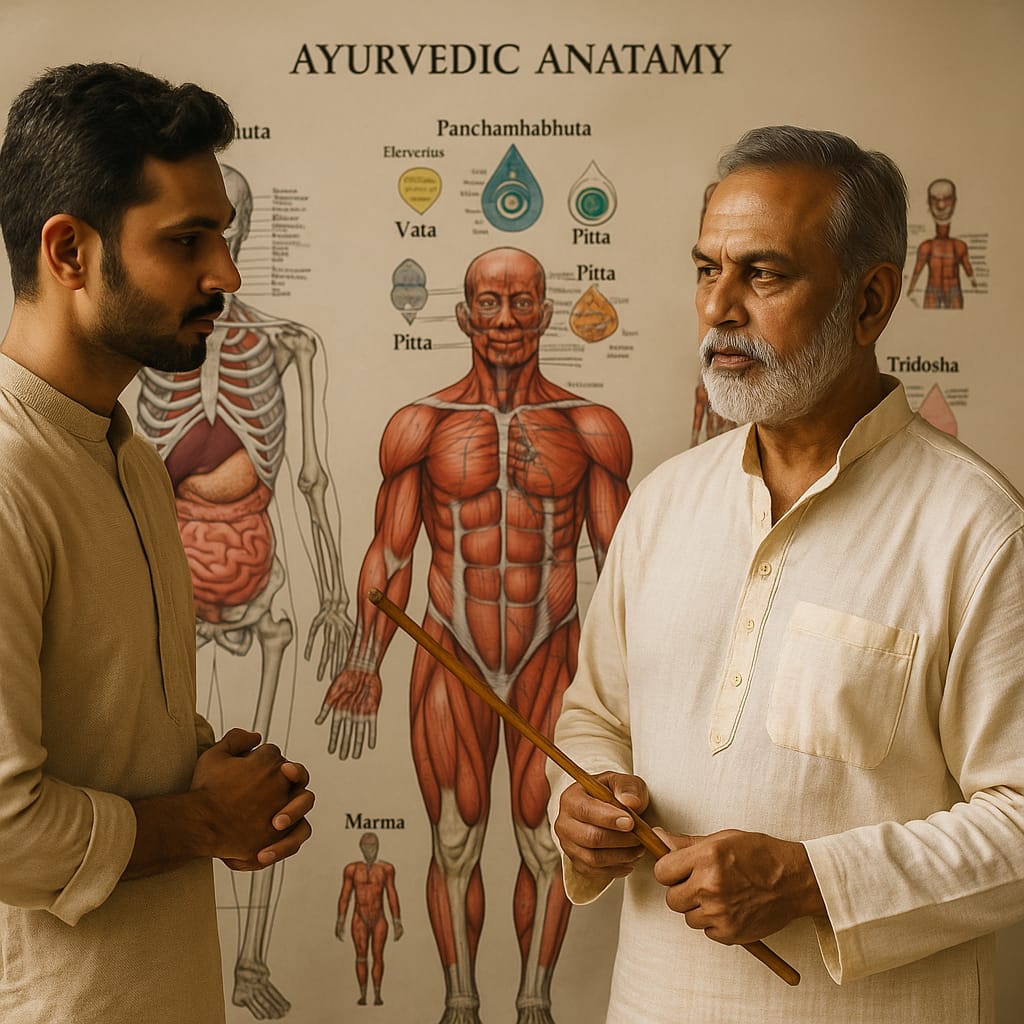
These concepts help understand the body's form, function, and interconnectivity beyond the physical level.
Rachana Sharir includes the study of Garbha Sharir (embryology) and Sharir Rachana (anatomy) from both classical texts like Charaka Samhita and Sushruta Samhita. It also provides insight into the origin, development, and importance of body organs and systems, establishing a strong foundation for diagnosis and treatment in clinical practice.
This subject bridges ancient anatomical wisdom with modern medical knowledge, making it essential for Ayurvedic students to understand the body holistically, including physical, mental, and spiritual dimensions.
Rasashastra and Bhaishajya Kalpana is a vital branch of Ayurveda that deals with the preparation, processing, and standardization of Ayurvedic medicines. It combines the ancient knowledge of alchemy (Rasa) and pharmaceutics (Bhaishajya Kalpana) to create safe, potent, and effective formulations for the treatment of various diseases.
Rasashastra primarily focuses on the use of metals, minerals, and mercury (Parada) after proper purification (Shodhana) and incineration (Marana). These substances, when processed appropriately, become Bhasmas, which are therapeutically active and highly absorbable.
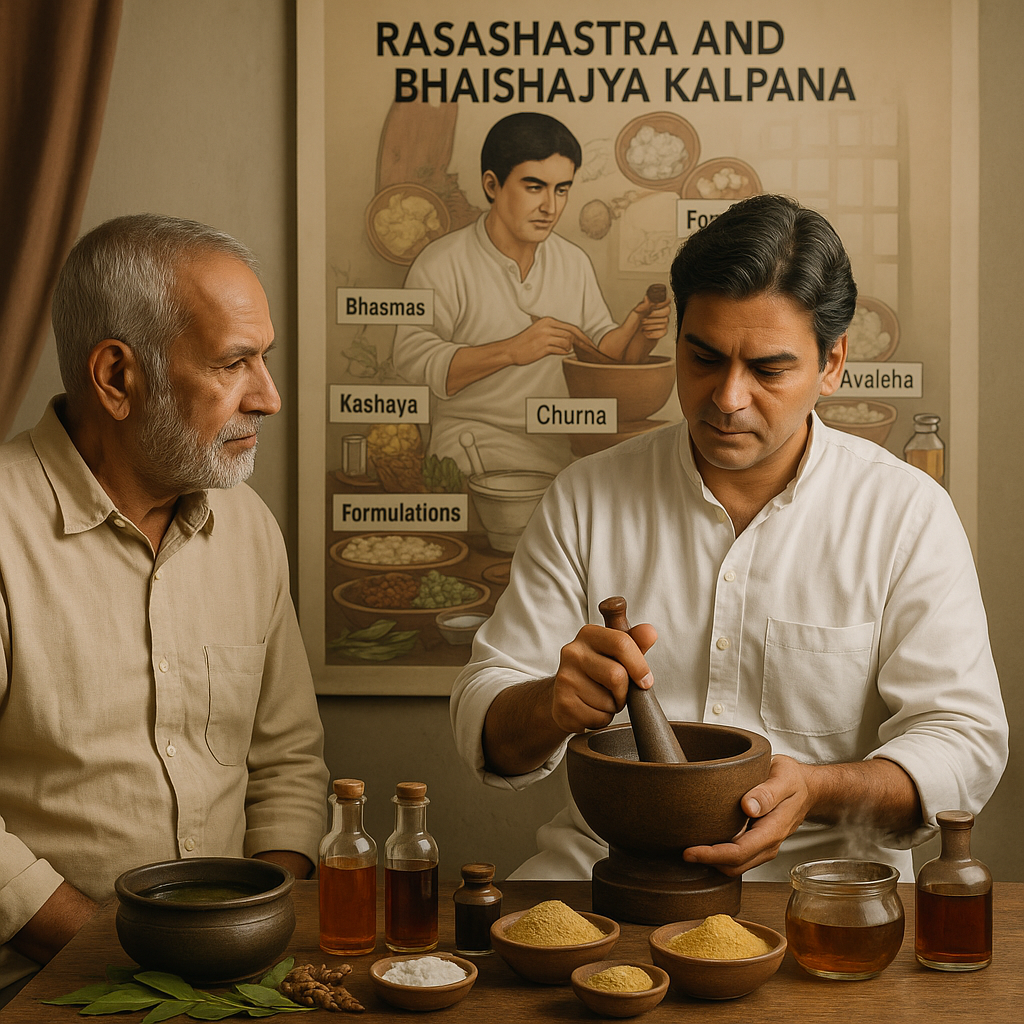
Rasashastra also involves the preparation of potent formulations like Rasa, Gutika, Vati, Pishti, and Parpati, which are used in treating chronic and complicated diseases.
Bhaishajya Kalpana deals with the herbal drug formulation aspect, including the collection, preservation, processing, and preparation of various dosage forms such as Kashaya (decoctions), Churna (powders), Avaleha (jams), Asava-Arishta (fermented preparations), and Taila/Ghrita (medicated oils/ghee).
This subject emphasizes standardization, quality control, safety, and shelf-life of Ayurvedic medicines in accordance with classical texts and modern pharmaceutical principles.
Rasashastra and Bhaishajya Kalpana together form the backbone of Ayurvedic pharmaceutics, ensuring that traditional formulations are prepared with scientific precision, maintaining their efficacy, purity, and safety in modern clinical practice.
Sanskrit Samhita Siddhant is a core subject in Ayurveda that encompasses the philosophical principles, classical texts (Samhitas), and linguistic foundation (Sanskrit) upon which the science of Ayurveda is built. It helps students understand the original teachings of ancient seers (Acharyas) in their authentic form.
The term "Samhita" refers to the compiled classical treatises such as Charaka Samhita, Sushruta Samhita, and Ashtanga Hridaya, which are written in Sanskrit, the language of Ayurveda. These texts explain every aspect of life, health, disease, and treatment in a structured and holistic manner.
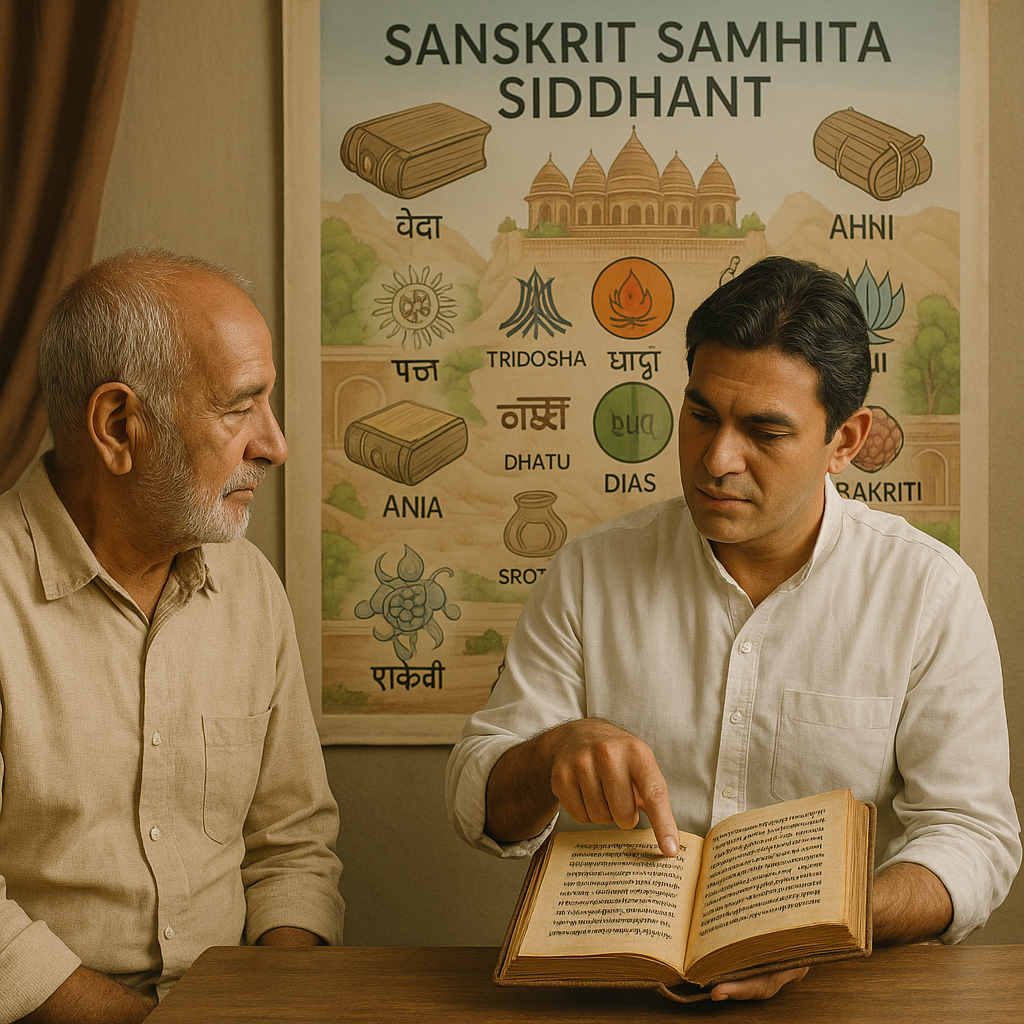
The Siddhanta (principles) discussed in these treatises form the theoretical framework of Ayurvedic diagnosis and treatment.
This subject focuses on teaching Ayurvedic terminologies, fundamental concepts like Tridosha, Dhatu, Mala, Agni, Ojas, Srotas, and Prakriti, and the correct interpretation of sutras (verses). Knowledge of Sanskrit grammar is also imparted to help students accurately read, understand, and memorize classical verses.
Sanskrit Samhita Siddhant thus plays a crucial role in preserving the purity of Ayurvedic knowledge, enabling students to apply ancient wisdom in modern contexts with clarity, precision, and respect for tradition.
Shalakya Tantra is a specialized branch of Ashtanga Ayurveda that deals with the diagnosis and treatment of diseases affecting the organs located above the clavicle, primarily the eyes (Netra), ears (Karna), nose (Nasa), throat (Mukha), head (Shira), and oral cavity. The term “Shalakya” is derived from ‘Shalaka’, meaning probe or instrument, indicating the use of surgical and parasurgical tools in treatment.
This branch offers detailed descriptions of various eye diseases (Netra Roga), ear diseases (Karna Roga), nasal conditions (Nasa Roga), oral disorders (Mukha Roga), and head-related ailments, along with their etiology, pathogenesis, and treatment.

It includes both internal medicines and external therapies, such as Netra Tarpana, Nasya, Karnapoorana, Gandusha, and Dhoomapana.
Shalakya Tantra also incorporates principles of Ayurvedic ophthalmic surgery, and is considered the ancient foundation of ENT and dental sciences. Sushruta, known as the father of surgery, has made remarkable contributions to this field, especially in eye surgery and ear treatments.
With the increasing incidence of lifestyle-related eye and ENT problems, Shalakya Tantra offers natural, non-invasive, and holistic treatment approaches, making it highly relevant in today’s integrative healthcare system.
Shalya Tantra is one of the eight classical branches of Ashtanga Ayurveda and deals with surgical and parasurgical management of diseases. The term “Shalya” means foreign body or sharp instrument, and “Tantra” means technique or system. Thus, Shalya Tantra encompasses the diagnosis, surgical intervention, and post-operative care using both traditional Ayurvedic methods and surgical tools.
Acharya Sushruta, regarded as the Father of Surgery, authored the Sushruta Samhita, a foundational text in Shalya Tantra.
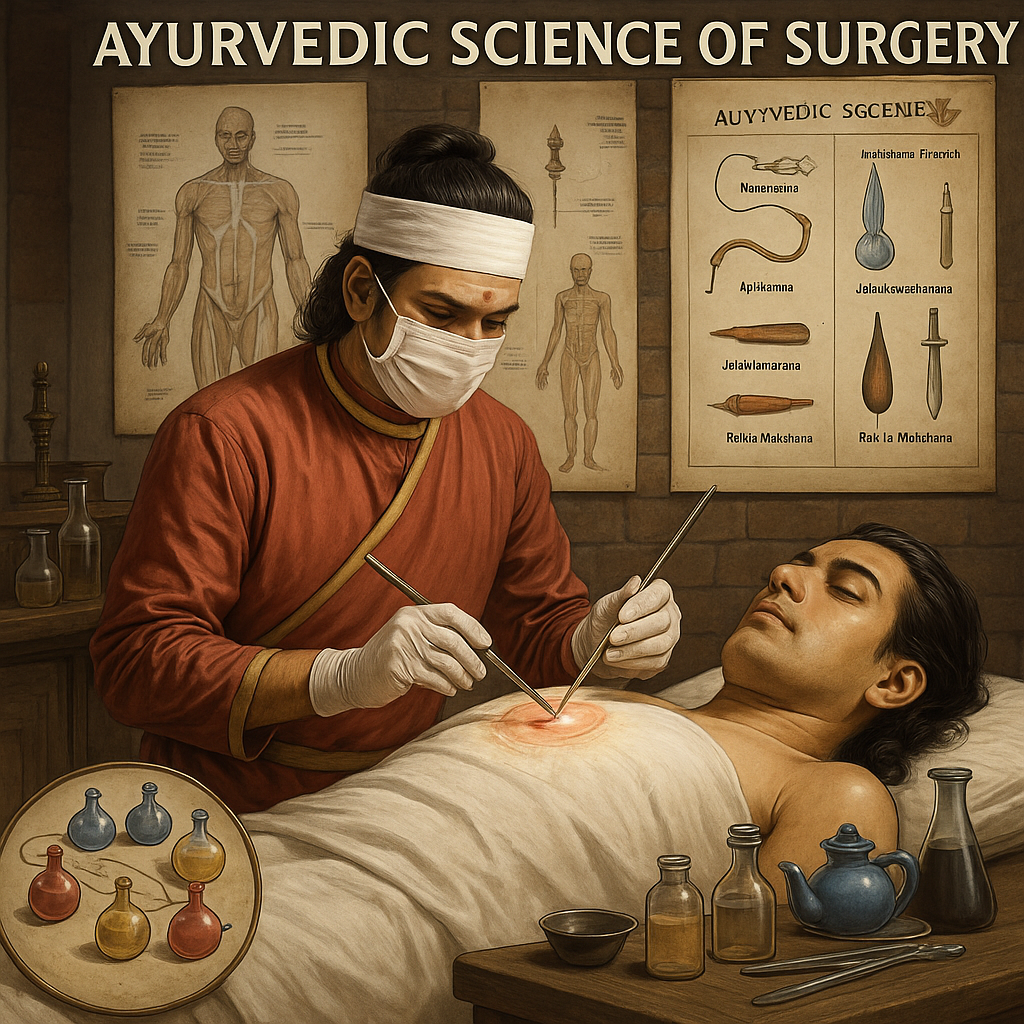
It describes over 300 surgical procedures, 120 surgical instruments, and detailed techniques for incision, excision, suturing, cauterization, and management of wounds, fractures, abscesses, tumors, piles, fistula-in-ano (Bhagandara), urinary calculi, and cataracts.
This branch also includes parasurgical procedures such as:
Shalya Tantra emphasizes aseptic techniques, pre- and post-operative care, and the use of herbal formulations for wound healing and pain management.
In modern times, Shalya Tantra holds significant value in integrative surgical practice, especially in anorectal disorders, wound care, and non-healing ulcers, offering effective alternatives with minimal side effects.
Swasthavritta is a core branch of Ayurveda that focuses on maintaining health and preventing diseases through a disciplined lifestyle. The term "Swastha" means a healthy individual, and "Vritta" means regimen or conduct. This branch emphasizes the importance of following daily (Dinacharya), seasonal (Ritucharya), and ethical (Sadvritta) routines, along with proper diet, hygiene, sleep, and exercise to preserve health and promote longevity.
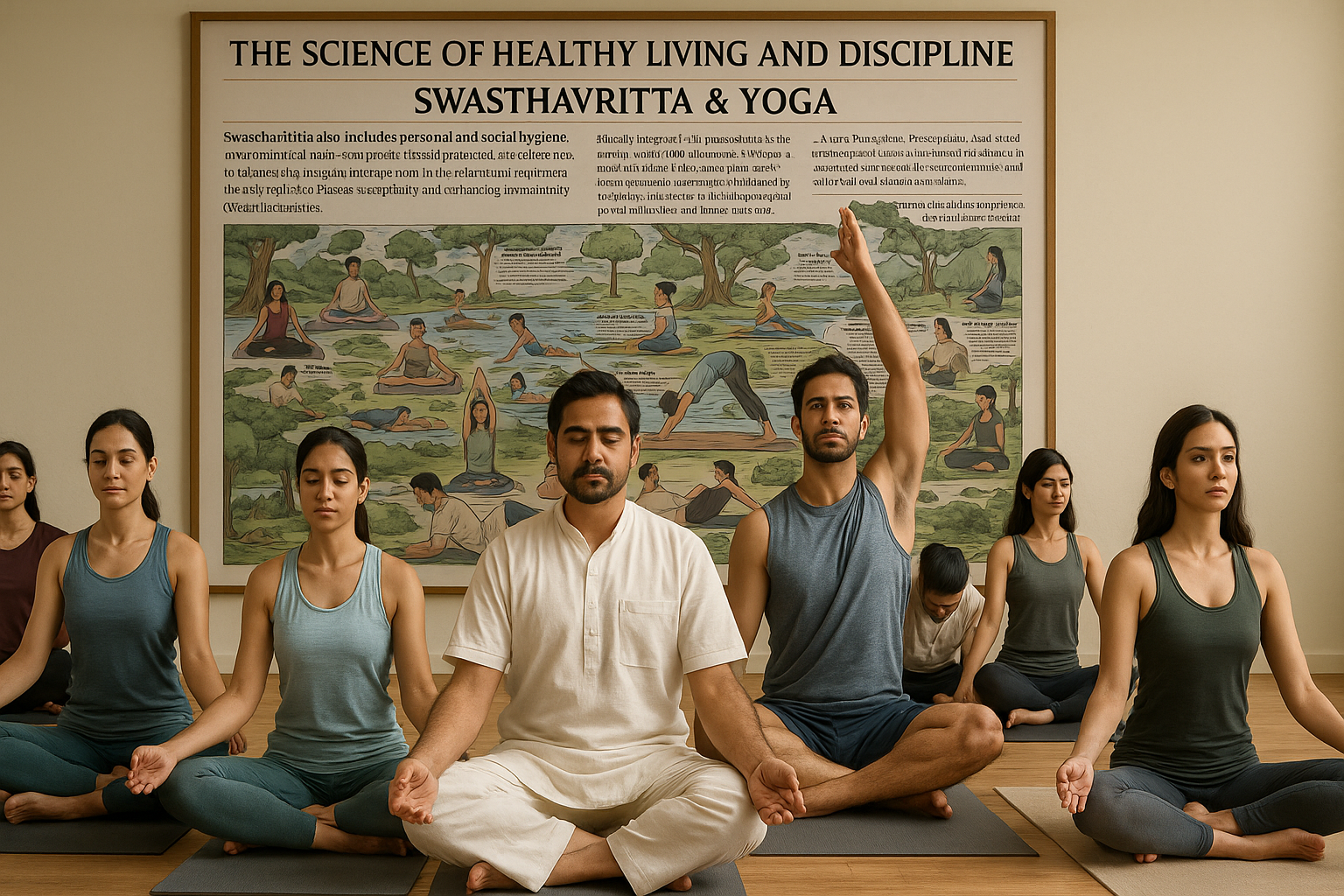
Swasthavritta also includes personal and social hygiene, environmental health, and public health practices. It teaches how to balance the Tridosha through right living and natural rhythms, thereby reducing disease susceptibility and enhancing immunity (Vyadhikshamatva).
Closely integrated with Swasthavritta is the science of Yoga, which aims at harmonizing the body, mind, and spirit. Based on the principles of Patanjali's Ashtanga Yoga, it includes Yama, Niyama, Asana, Pranayama, Pratyahara, Dharana, Dhyana, and Samadhi. Regular practice of yoga improves flexibility, strengthens organs, reduces stress, and supports mental clarity and emotional stability.
Together, Swasthavritta and Yoga form the preventive and promotive arm of Ayurveda, guiding individuals toward a balanced and disease-free life through natural, sustainable, and holistic practices.